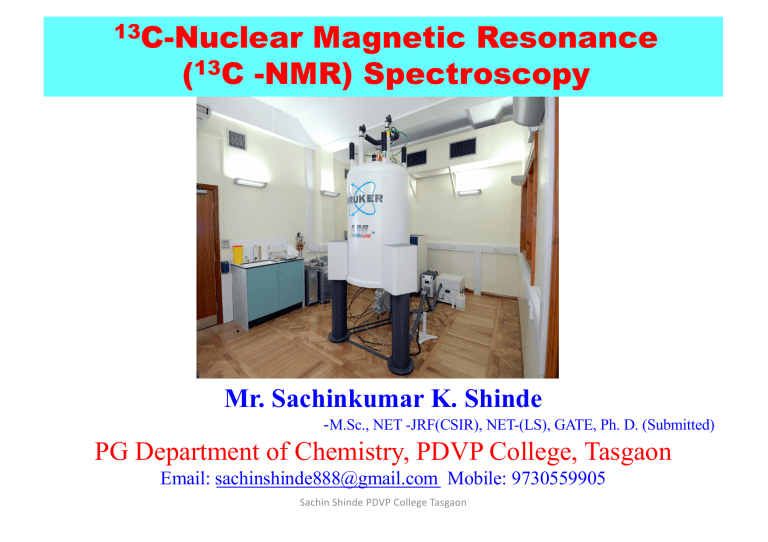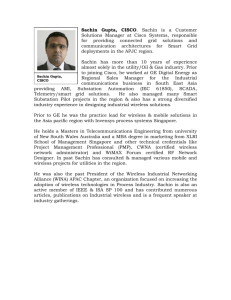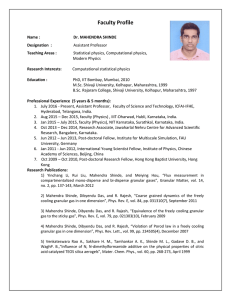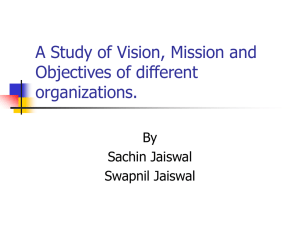
13C-Nuclear
Magnetic Resonance
(13C -NMR) Spectroscopy
Mr. Sachinkumar K. Shinde
-M.Sc., NET -JRF(CSIR), NET-(LS), GATE, Ph. D. (Submitted)
PG Department of Chemistry, PDVP College, Tasgaon
Email: sachinshinde888@gmail.com Mobile: 9730559905
Sachin Shinde PDVP College Tasgaon
1
Syllabus
Ø General considerations;
Ø Chemical shift [aliphatic, olefinic, alkyne, aromatic, heteroaromatic and carbonyl
compounds];
Ø Problems associated with 13C,
Ø FT- NMR,
Ø Proton decoupled off resonance.
Sachin Shinde PDVP College Tasgaon
2
Carbon-13 (13C)-NMR Spectroscopy
Spin Quantum No. I = 1/2
Magnetic moment µ>0
Quadrapole Q=0
13C
Couples with;
X
13C
Abundance 1.109 %
19F
1H
2D
31
Splitting by;
2nI+1 or n+1 rule
Same as proton
P
Chemical Shift (δ) 0-220 ppm
Internal std. TMS
ØMagnetogyric ratio of carbon (g =68) is less than that of proton (g =268) .
Ø13C nuclei resonance 6000 times weaker than 1H-nuclei.
Ø13C-NMR resonance (25 MHz) frequency ¼ less than1H resonance (100 MHz) frequency.
ØHomo-nuclear (13C-13C) splitting does not occur.
ØHetero-nuclear (13C-1H) splitting occurs through one bond coupling (1JC-H=100-250 Hz).
An important parameter derived from 13C-NMR spectra is the chemical shift
Sachin Shinde PDVP College Tasgaon
3
Number of Signals
Using symmetry and electronic environment
Sachin Shinde PDVP College Tasgaon
4
Number of Signals
Mono substituted Benzene
Sachin Shinde PDVP College Tasgaon
5
Number of Signals
Di-substituted Benzene
One group
Two group
Sachin Shinde PDVP College Tasgaon
6
Number of Signals
Tri-substituted Benzene
One group
Two group
Tree group
Sachin Shinde PDVP College Tasgaon
7
No. of of
Signals
Number
Signals
Using symmetry and electronic environment
Sachin Shinde PDVP College Tasgaon
8
Number of Signals
Using symmetry and electronic environment
Sachin Shinde PDVP College Tasgaon
9
Chemical Shift (δ =0-220 ppm)
TMS
Electronegativity, hybridization and anisotropy effect same fashion as 1H-NMR
Sachin Shinde PDVP College Tasgaon
10
Identify chemical shift
Sachin Shinde PDVP College Tasgaon
11
Calculation of Chemical Shift Value
Sachin Shinde PDVP College Tasgaon
12
Splitting of signals in 13C–NMR
Homonuclear (13C-13C) Coupling= Not observed (low abundance)
Heteronuclear (13C-1H) Coupling=
Ø Mostly observed through one bond coupling (1JC-H).
Ø Splitting occurs by n+1 rule
Ø Coupling constant 1J=100 to 250 Hz (larger than H nuclei)
Sachin Shinde PDVP College Tasgaon
13
Proton-coupled Spectra
A spectra that show the spin-spin splitting between Carbon-13 and the
proton directly attached to it are called proton coupled spectra.
Homo = H-H & C-C
Hetero = C-H
Nuclear coupling observed
Very complex
Ø Very complex spectra often difficult to analysis.
Ø The multiplets from different carbons commonly overlaps
Ø
13C-H
coupling constant are frequently larger than the chemical shift differences of the
carbons in the spectrum.
Sachin Shinde PDVP College Tasgaon
14
Proton Decoupled Spectra
A proton decoupling is process by simultaneously irradiating all of the
proton in the molecule with a broad spectrum of frequencies in the proper
range (approximately 1000 MHz).
- Second frequency generator is used for decoupler.
Only Singlets
All Nuclear coupling disappears
Ø Avoids overlapping multiplets.
Ø Only Singlets are observed (All carbons become singlets).
Ø Advantages: Peak intensity increases due to NOE effect.
Signal to noise ratio improve.
Ø Disadvantage: Information on attached hydrogen is lost.
Sachin Shinde PDVP College Tasgaon
15
Proton-coupled and Decoupled 13C-NMR Spectra
Homo = H-H & C-C
Hetero = C-H
All Nuclear coupling observed
Very complex
Only Singlets
All Nuclear coupling disappears
Sachin Shinde PDVP College Tasgaon
16
Off resonance decoupled spectra
In off resonance decoupled spectrum, the coupling between each carbon
atom and each hydrogen atom attached directly (13C-H) are observed by n+1
rule.
Decoupler irradiates the sample at 1000–2000 Hz upfield or 2000–3000 Hz downfield.
The n+1 rule can be used to determine whether carbon atom has three, two, one or no
hydrogen attached.
t
t
1-propanol
q
q
t
t
CH3- CH2-CH2-OH
Ø Apparent magnitude of coupling constant is reduced. (remove overlapping of multiplets).
Ø Only shows one-bond hetero nuclear coupling (removes other remote carbon coupling).
Ø The frequency of decouple is held low to avoid complete decoupling.
Sachin Shinde PDVP College Tasgaon
17
Off- Resonance Spectra of 1-propanol
Off Homo Nuclear coupling
(H-H) (C-C)
Only Hetero (C-H)
Nuclear coupling observed
Sachin Shinde PDVP College Tasgaon
18
Example
Sachin Shinde PDVP College Tasgaon
19
Distortionless Enhancement Polarization Transfer ( DEPT)
Distortionless enhancement by polarization transfer (DEPT) is a NMR method used
for determining the presence of primary (CH3), secondary (CH2) and tertiary (CH)
carbon atoms.
The DEPT experiment differentiates between CH, CH2 and CH3 groups by variation
of the selection angle parameter:
i.
135° angle gives all CH and CH3 in a phase (+Ve) opposite to CH2 (-Ve) (DEPT-135)
ii. 90° angle gives only CH groups (+Ve), the others being suppressed (DEPT-90)
iii. 45° angle gives all carbons with attached protons in phase (+Ve): (DEPT-45)
Ø Signals from quaternary carbons and other carbons with no attached protons are always
absent (due to the lack of attached protons).
Ø The polarization transfer from 1H to
sensitivity over the normal
13C
13C
has the secondary advantage of increasing the
spectrum (which has a modest enhancement from the
nuclear overhauser effect (NOE) due to the 1H decoupling).
Sachin Shinde PDVP College Tasgaon
20
Distortionless Enhancement Polarization Transfer ( DEPT)
4
-CH, CH3 Positive
-CH2 inverted/Negative
3
Only -CH
All -CH, CH2, CH3
2
1
No quaternary C
All Carbons
Sachin Shinde PDVP College Tasgaon
21
DEPT spectrum of Propyl benzoate
O
O
Propyl benzoate
DEPT-135
DEPT-90
DEPT-45
Sachin Shinde PDVP College Tasgaon
22
Examples of DEPT
Sachin Shinde PDVP College Tasgaon
23
Attached Proton Test (APT) spectra
The attached proton test (ATP) is a 1D 13C-NMR experiment that is used as an aid to
assignment by separating carbons unattached to protons (c) and CH2 signals from CH
and CH3 signals.
The APT experiment yields methine (CH) and methyl (CH3) signals positive and quaternary
(C) and methylene (CH2) signals negative.
Ethyl benzene
APT spectrum of ethylbenzene showing
CH and CH3 positive While
CH2and quaternary C are negative
Ø It is slightly less sensitive than DEPT but a single experiment shows all carbon signals at once unlike
DEPT that supresses quaternary carbons and requires up to three different acquisitions to yield full
results.
Ø It is, however, sometimes possible that a CH and CH2 signal have coincidentally equivalent chemical
shifts resulting in annulment in the APT spectrum due to the opposite phases. For this reason the
conventional 13C{1H} spectrum are occasionally
also
acquired.
Sachin Shinde PDVP
College
Tasgaon
24
DEPT and APT spectra
Sachin Shinde PDVP College Tasgaon
25
Heteronuclear coupling of carbon to fluorine-19
Proton Decoupled
Proton Coupled
Sachin Shinde PDVP College Tasgaon
26
Heteronuclear coupling of carbon to Phosphorus-31
Sachin Shinde PDVP College Tasgaon
27
University Questions
Q. If operating frequency for 1H-NMR is 300 MHz, what will it be for 13C-NMR? (2 M)
Q. In 13C-NMR, signal due to d6-DMSO appears as a group of…………..peaks. (2M)
Q. In CMR, CDCl3 appears as triplet, explain. (2M)
Q. Write the structure of an organic compound (MF: C4H10O2) which shows only two singlet in
its CMR spectrum at d 20 and 52 ppm). (2M)
Q. Suggest the structures of three isomeric ketones having same molecular formula (C5H10O) and
exhibits three, four and five signals in 1H-decoupled 13C-NMR spectrum. (2M, 3M)
Q. How many signals do you expect in broad band decoupled CMR spectrum of following
compound. ( 2 M)
O
Q. Write the structures of all isomeric alcohols (MF: C4H10O) which exhibits three/four signals
in their CMR spectrum. (4 M)
Sachin Shinde PDVP College Tasgaon
28
Calculation
of Chemical
Shift Value
University
Questions
Q. Calculate dc values for aromatic carbons in p-chlorobromo benzene. (5 M)
Given
: Basic dc for aromatic ring c= 128.5 ppm
Group :
ipso
ortho
meta
para
Cl
:
8.2
-3.4
0.8
-7.0
Br
:
8.7
-4.3
0.65
-6.0
Q. Calculate dc values for aromatic carbons in 4-aminoacetophenone. (4 M)
Given
: Basic dc for Ar-C= 128.5 ppm
Group :
ipso
ortho
meta
para
NH2
:
18.2
-13.4
0.8
-10.0
COCH3 :
8.9
0.1
-0.1
4.3
Q. Calculate dc values for the aromatic ring carbons in following compound. (4 M)
Given
: Basic dc for Ar-C= 128.5 ppm
O
Group :
ipso
ortho
meta
para
-OR
:
31.4
-14.4
1.0
-7.7
-COR
:
8.2
1.2
0.6
5.8
OHC
-R
:
9.3
0.7
-0.1
-2.9
Sachin Shinde PDVP College Tasgaon
29
Calculation
of Chemical
Shift Value
University
Questions
Q. Calculate chemical shift values for only olefinic carbons in the following compound. (2 M)
Given
: Basic Value: 123.3
COCH3 (a) = 15 ppm; COCH3 (a’) = 6 ppm; CH3 (a’) = 10.6 ppm.
Q. Write the structures of two isomeric bromides which have following spectral data. Assign the
signals to various carbon atoms in the structures. (5M)
MF: C3H5Br
Compound A: 32.6 (t), 118.8 (t), 134.2 (d).
Compound B: 12.0 (t), 16.8 (d).
Q. Deduce the structure of an organic compound on the basis of following data. (4 M)
MF: C5H8O
d (ppm)
:
22,
52,
125,
135,
168.
(Off-resonance decoupling) :
q,
q,
t,
s,
s.
Q. Write the structures for all the isomers of a compounds (MF: C6H14) which have following
data.
Isomer-I : 19.1 (q), 33.9 (d).
Isomer-II : 13.7 (q), 22.9 (t), 31.9 (t).
Isomer-III : 11.1 (q), 18.4 (q), 29.1 (t), 36.4 (d).
Isomer-IV : 14.0 (q), 20.5 (t), 22.4 (q), 27.6 (d), 41.6 (t).
Isomer-V : 8.5 (q), 28.7 (q),Sachin
30.2
(s),PDVP
36.5
(t). Tasgaon
Shinde
College
30
Examples
on Off resonance
and DEPT
University
Questions
Q. Considering following example, sketch its broad band decoupled CMR spectrum (Exact delta
values not expected) and justify the use of DEPT scans in correct assignments of chemical shift
values. (6 M)
COOCH2CH3
H 2N
O
Q. Sketch the off-resonance decoupled and proton decoupled 13C-NMR spectrum of followings
COOCH3
organic compound.
(5 M)
Br
(Exact d values are not expected)
Q. Sketch the off-resonance decoupled, proton decoupled and DEPT-135 CMR spectrum of 4methoxy benzyl cyanide (exact d values are not expected). (4 M)
Q. Using 4-MeO-C6H4-COCH2-CH3 as a model compound, sketch the off-resonance decoupled
and H-decoupled 13C-NMR spectrum (6 M)
Sachin Shinde PDVP College Tasgaon
31
Questions
University
Questions
Q. Sketch the proton coupled as well as proton decoupled
compounds. (4 M)
i) p-Chloropropiophenone
ii) Ethyl acetate
13C-NMR
spectrum of following
Q. In proton decoupled 13C-NMR spectrum comment on the signal intensity for CH3, H2C-CH2
and CH carbons. Justify your answer. (4 M).
Q. Explain, how cursory examination of 13C-NMR spectrum could be useful to judge the
presence of alkyl, vinyl, alkyne, nitrile and amide group in the molecule. (5 M)
Sachin Shinde PDVP College Tasgaon
32
Examples:
Sachin Shinde PDVP College Tasgaon
33
Sachin Shinde PDVP College Tasgaon
34
Sachin Shinde PDVP College Tasgaon
35
Sachin Shinde PDVP College Tasgaon
36
Sachin Shinde PDVP College Tasgaon
37
Sachin Shinde PDVP College Tasgaon
38
Sachin Shinde PDVP College Tasgaon
39
Sachin Shinde PDVP College Tasgaon
40
Sachin Shinde PDVP College Tasgaon
41
Sachin Shinde PDVP College Tasgaon
42




